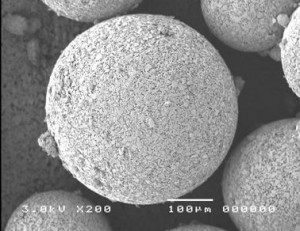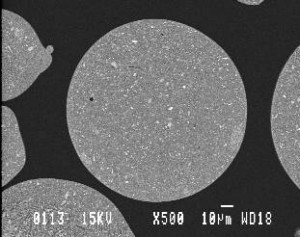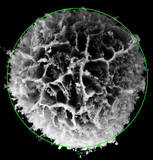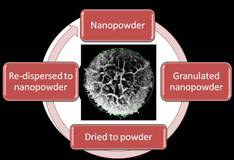For optimal powder compaction in for ex uniaxial die pressing of metal or ceramic powders, it is important to have homogeneous granules where the binder and fine particles are well distributed in each granule. By using Freeze Granulation you can achieve this.
News
Can you make spherical granules?
Yes, with Freeze Granulation it’s possible to make spherical, homogeneous and dust-free granules with optimal flowability which is critical for automatic uniaxial pressing of for ex ceramics and metal powders.
You can expect spherical and homogenous granules of powders in terms of distribution of particle size and other possible additives you want to use. The granules with a size distribution in the range of 50-300 microns will have weak inter particle bonding making them easy to break down in pressing or re-disperse into another formulation. Very much depend upon how you intend to process the powder and depending on that, adaptation can be made. If you tell us more we can further discuss the opportunities.


Do you have a powder or liquid processing project?
Do you need support in your powder or liquid processing project? We have long experience in processing all kind of materials, so please do not hesitate to contact us if you need some assistance in your powder processing project.
If you don’t find the information you need, please contact us. We’re always glad to help.
What is the meaning of homogeneous granules?
Freeze Granulation for optimal granule properties compared with spray drying. Homogeneous granules with no void formation, no migration of fine particles or binders, and no formation of hard dry shell.
Spray drying compared with Freeze Granulation
What is the difference between spray drying and Freeze Granulation? For more info, please go to our Pros & Cons.
The best way to find out if Freeze Granulation is suitable for your material is to let us do a test granulation. Freeze Granulation will be more expensive than spray drying as it is a two-step process. The relative difference depends on the scale and Freeze Granulation is more suitable for small or medium size batches where the demands on granule quality is high whereas spray drying is most suitable for large scale processing.

How to avoid agglomeration of nanoparticles or powders?
By using the most suitable dispersing and binder system in combination with Freeze Granulation, you will be able to avoid aggregates or agglomerates in your granules and in the final component.
Please contact us and we will further discuss the opportunities with Freeze Granulation on your powder system and read more on technology and we propose a Granulation Test of your powder system.
Handling and Processing of Nanopowders
We have long experience in handling and processing of nanoparticles/nanopowders, for example, mix and granulate different powders and binders for to achieve improved homogeneity and increased performance of the final product.

Freeze granulation gives the possibility to granulate nanoparticles/nanopowders achieving granules with high degree of homogeneity which are easily re-dispersed (if applicable) in a liquid or dis-integrated at a pressing operation. This is owing to the week inter-particle bonding compare to what is obtained in conventional drying. Consequently, the nanosized material properties will be preserved, i.e. nano will still be nano. Freeze-drying also prevents oxidation of metals or non-oxide materials as conventional drying do not, especially critical for nanopowders.

EuroNanoForum 2011
30 May – 1 June, 2011
Budapest, Hungary
PowderPro thank you for your visit to our stand B14 in Budapest.
http://www.euronanoforum2011.eu/
POWTECH 2011
11-13 October, 2011
Nürnberg, Germany
PowderPro invites you to our stand.
http://www.powtech.de/en
Suitable binder systems for Freeze Granulation
We have long experience in powder processing of different powder and chemical based systems. PVA-PEG binder system is one example of a commonly used system for water-based Freeze Granulation, please check our paper Development of water-based processing of silicon nitride materials.
Please use this form to contact us if you need support in suitable binder systems for granulation of your powder system and read more on Technology.

